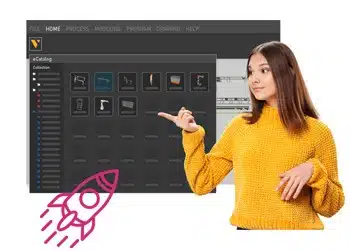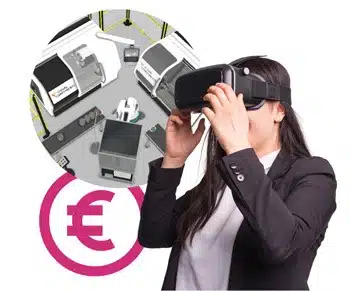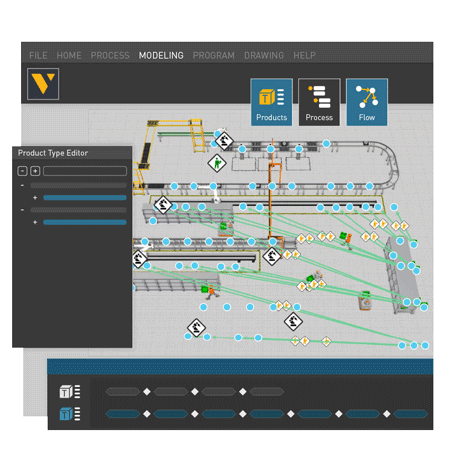Visual Components: Industrial 3D simulation software
Save time and avoid errors with offline simulation and programming software.
Visual Components is 3D production simulation software that offers innovative tools to help you efficiently develop your production lines
- Design and operating simulation
- Offline robot programming
- Cycle time analysis and optimization
Visual Components is ideal for automotive, aerospace, electronics, pharmaceutical, food, and many other industries

Manufacturer / Integrator of machines & robots
- Accelerate your sales cycle
- Reduce the risk of errors
- Make communication easier
- Differentiate yourself from the competition

Industrial manager
- Quickly design an implementation
- Test it to avoid errors
- Optimize cycle times
- Program your robots offline

Teacher
- Develop student employability
- Factory operation simulation
- Simulate all types of resources
- Advanced robot programming
View the 3D demo
Click hereView a car door assembly installation carried out in collaboration with the ECAM training center
This 360° view installation is a work which was carried out by Mr. Dubyk Erwan, BTS student at Saint Aubin La Salle in Angers as part of a group work.
Features of Visual Components 3D simulation software
Visual Components is ideal for designing and optimizing industrial automation, packaging and palletizing or even the logistics of your factory: analyze your risks likely to create blockages in your production lines, configure presentations, create animated 3D PDFs or even high-resolution images and videos that you can present internally or to external clients.
3D simulation for the design and optimization of production and warehousing lines

Simulate concepts in minutes
Quickly design your concepts using ready-to-use 3D models with out-of-the-box features.
More than 2,300 ready-to-use components (virtual models from dozens of manufacturers widely used in the industry: robots, conveyors, AGVs, mixers, tables, separators, etc.) to design your lines or those of your customers in just a few clicks.
Can't find the components you need in the software? Import your own components from CAD software.
Bring static designs to life and simulate your concept drawings without the need for specialized technical skills.
Design digital twins
Replicate the real world: Connect simulations to physical assets such as automata and robot controllers.
Create digital twins and virtually commission your projects.
Reduce delivery times for your automation projects.
Reduce risks
Whether you're building a new factory, expanding your current site, or automating your processes, simulation provides a virtual environment in which you can test your plans in advance.
This allows you to spot hidden problems and minimize investment risks.
Maximize efficiency
Collect simulation data to better understand your operations and production assets.
Test different scenarios to optimize your production , resource usage, floor space usage.
View your line statistics to measure cycle times and identify bottlenecks . This information can be easily exported (PDF or Microsoft Excel)
Fast and precise programs
Program your robot with user-friendly and fast one-click programming.
Program robots of all brands with detailed kinematics.
Visualize them in simulation for various applications such as welding, sealing, cutting, painting, handling, etc.
Store your process knowledge and easily reuse programs for future projects.
Eliminate bot downtime
Increase the utilization rate of your robots with intelligent offline programming.
Minimize downtime caused by manual programming in processes such as welding, processing or spraying.
Faster programming
Quickly generate programs in virtual robot cells , wherever you are in the world.
Let the software validate and optimize programs before sending them to production to avoid costly errors
Increased security
Reduce the risks associated with accidents and injuries. Program heavy industrial robots with OLP software from the comfort of your office, without the need to be physically present in the robot cell.
Assistance with the sale of equipment and integration services

Accelerate your sales cycles
With Visual Components, you can create an implementation in record time, without needing advanced knowledge of complex software. Your sales team is more autonomous, can respond to more files and win more contracts!
- Choose machines from 2300 ready-to-use components
- Drag them into the 3D environment, connect them,
- Adapt the parameters (dimensions, speed, color)
- You have a 3D simulation!
Manufacturers, integrate your own products into Visual Components from CAD files using the component modeling tool and customize them (geometry, behavior and properties).
Reduce the risk of error
Show your customers the 3D rendering
Your clients can zoom in, change angles and easily understand every aspect of your proposal, far beyond a 2D plan.
With Visual Components Experience (available in PREMIUM version), introduce your customers to a new way to experience the simulation of your implementations on mobile or in virtual reality.
This makes it even easier for them to see every detail and visualize your proposal in an immersive way.
Export communication tools
The OLP offer has been redesigned to meet the needs of the industry.
- Cutting-edge technology for offline programming of robots, regardless of robot brand or process.
- Helping manufacturers increase the utilization rate of their robots to over 90%.
- Enable manufacturers to store process knowledge in software to improve quality and productivity.
- Solutions to facilitate “DESIGN FOR MANUFACTURING”!

Why choose Visual Components?
World leader in industrial 3D simulation
World leader in the production simulation sector, Visual Components offers machine builders and system integrators a simple solution to simply and quickly design and validate their production lines or those of their customers.
Simple and quick to use
To support planning processes and decision-making as well as application development, 3D simulation software offers numerous manufacturing design tools.
Thanks to a large library of configurable and interconnectable components (conveyors, robots of all kinds, CNC, feeders, packaging machines, etc.) you will be able to visualize your layouts in just a few clicks !
They use Visual Components
During a 20-minute video, our VISUAL COMPONENTS expert integrator will take stock of your line design practices and estimate the time you could save thanks to Visual Components

Latest articles about industrial 3D simulation and offline programming of robots

A window to innovation: simulating automation in window manufacturing
Automating a window manufacturer's processes to better meet demand, yes… But where to start? The use of Visual Components 3D simulation software made it possible to identify the best sources of yield optimization, before investing.

Production simulation software: 5 advantages for system integrators
One of the keys to success for a systems integrator is to be able to provide rapid and accurate proposals to its clients. Production simulation software saves time on layout design

7 preconceived ideas about integrating production flow simulation software
There are many misconceptions about purchasing workflow simulation software: cost, learning curve, compatibility or functionality that already exists in other products. Find out why they are not true and why such
What is industrial simulation software?
Industrial simulation software is a powerful computing tool designed to digitally reproduce and analyze various aspects of industrial operations and processes.
It allows businesses to model virtual scenarios that mimic real-world conditions in a production or manufacturing environment.
These simulations are used to make informed decisions, optimize performance, reduce costs, minimize risks and accelerate product development.
Industrial simulation software is employed in a variety of industries, ranging from automotive to aerospace, manufacturing, logistics and many others.
They can be used to simulate production processes, workflows, supply chains, machines, control systems, etc.
These tools allow engineers, designers, and managers to test ideas, optimize systems, anticipate potential problems, and improve the overall efficiency of their operations.
Ultimately, industrial simulation software helps reduce development costs, minimize downtime, improve product quality, and enhance market competitiveness.
The use of industrial simulation software has become essential in the modern manufacturing sector, as it provides an effective way to gain a competitive advantage by optimizing processes and making informed decisions based on simulated data.
I already have CAD software, what use could this have for me?
CAD (Computer Aided Design) software and industrial simulation software are two distinct, although complementary, categories of computer tools that are widely used in industry for specific tasks.
CAD software:
CAD is mainly used for the design and modeling of products and components. CAD software allows engineers and designers to create 2D or 3D models of parts, assemblies or finished products. They provide functionality for drawing, dimensioning, annotating and documenting technical designs. CAD software is essential for creating plans, schematics, and models of parts or assemblies, which are used in the design process. They focus on the visual appearance and geometry of the products.
Industrial simulation software:
On the other hand, industrial simulation software focuses on modeling and analyzing the dynamic behavior of industrial systems. They allow you to simulate operations, processes, workflows and control systems, taking into account the complex interactions between components. These software are used to understand how a system will perform in real-world conditions. They help predict performance, detect bottlenecks, optimize processes and reduce risks.
In summary, the main difference is the purpose and scope. CAD software is intended for product design and modeling, while industrial simulation software focuses on analyzing the behavior of industrial systems. However, it is common to use these two types of software in tandem to create efficient, high-quality products by minimizing design errors and optimizing industrial operations.
With Visual Components, you can easily integrate your CAD models into the component library.
Why choose 3D industrial simulation software?
Choosing 3D simulation software has many significant advantages, whether for industrial companies or design professionals. Here are some compelling reasons to opt for such software:
1. Realistic visualization: 3D simulation software provides realistic visualization of products, processes and systems. This allows users to see and interact with 3D models that closely resemble real-world objects or scenarios, making concepts easier to understand and communicate.
2. In-depth analysis: 3D simulation makes it possible to analyze in detail the behavior of systems in real or simulated conditions. This may include performance analyses, stress tests, thermal evaluations, fluid simulations, etc. These analyzes help make informed decisions and optimize designs.
3. Reduced Costs: 3D simulation software helps identify and resolve design issues before they manifest in the real world, reducing costs associated with rework and manufacturing errors. They also help optimize designs for maximum efficiency.
4. Accelerate the development process: By integrating 3D simulation into the design process, companies can reduce development times by quickly identifying potential issues and taking corrective action. This helps bring products to market faster.
5. Innovation and Creativity: 3D simulation software encourages innovation by allowing designers to experiment with new ideas and push the boundaries of design. They provide an ideal platform for testing concepts without having to build expensive physical prototypes.
6. Training and Documentation: 3D simulations can be used for staff training, creation of manuals and documentation, making procedures and processes easier to understand.
7. Informed decision making: By using 3D simulations to model different options, companies can make informed decisions regarding investments, improvements and modifications to their products or processes.
In summary, choosing 3D simulation software is a wise investment to improve design, efficiency and competitiveness. It helps reduce costs, accelerate development, encourage innovation and provide better understanding of systems and products. To learn more about how 3D simulation software can benefit your business, please feel free to contact us or explore our website further for additional information.

